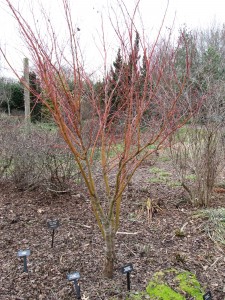Beni kawa Japanese maple (Acer palmatum ‘Beni kawa’) is a smaller version of the popular coral bark maple ‘Sango kaku’. It was introduced by Greer Gardens Nursery in Oregon in 1987. ‘Beni kawa’ matures to 12-15 feet tall and 8-10 feet wide, compared to 20-25 feet tall for ‘Sango kaku’. Both cultivars form a vase-shaped branched small tree or large shrub. The pale green bark on the trunk and stems turns coral red in winter.
The 5-7 pointed palmate leaves emerge soft green in spring, and fall foliage color ranges from yellow to orange. The leaves tend to emerge early in spring and may be subject to injury from late spring frosts. The small reddish flowers in spring are attractive up close, and are mostly inconspicuous from a distance.
The foliage may burn in direct summer sun in USDA zone 7 and 8, preferring some afternoon shade protection. Japanese maples grow in a compost rich, well- drained, and moderately acidic soil. Irrigation and mulching are desirable during summer dry spells and protect roots from dry winter winds. Pruning, if needed, is best performed during the spring and summer months to avoid significant sap bleeding from the pruning cuts.
There are no serious insect or disease problems. Beni kawa appears to be slightly more cold tolerant than Sango kaku. Beni kawa is sometimes mistakenly spelled “Beni gawa”.


 Posted in
Posted in 
